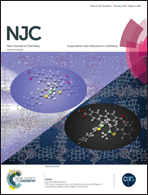Highly selective colorimetric and reversible fluorometric turn-off sensors based on the pyrimidine derivative: mimicking logic gate operation and potential applications†
Abstract
Two novel pyrimidine based 5-(2-hydroxybenzylideneamino)-6-amino-2-mercaptopyrimidin-4-ol (S1) and 5-(3-nitrobenzylideneamino)-6-amino-2-mercaptopyrimidin-4-ol (S2) receptors have been synthesized and characterized by various techniques. Both receptors showed 2 : 1 complexation stoichiometry with Ni(II) having binding constants 2.9 × 106 (S1) and 2.1 × 106 (S2) calculated by the Job's plot based on the UV-Vis absorption studies. The binding stoichiometry was also supported by the ESI mass spectra and NMR titration. The addition of Ni(II) to both chemosensors, S1 and S2 leads to the fluorescence quenching of S–Ni(II), forming an off sensing type system with the limits of detection 33 μM and 48 μM respectively. It was observed that S1 and S2 achieved electrochemical changes in reduction and oxidation potentials after the addition of the nickel metal ion. DFT calculations have revealed that the energy gap between the HOMO and LUMO of S1 and S2 has significantly decreased upon coordination with Ni(II) in the gas phase.


 Please wait while we load your content...
Please wait while we load your content...